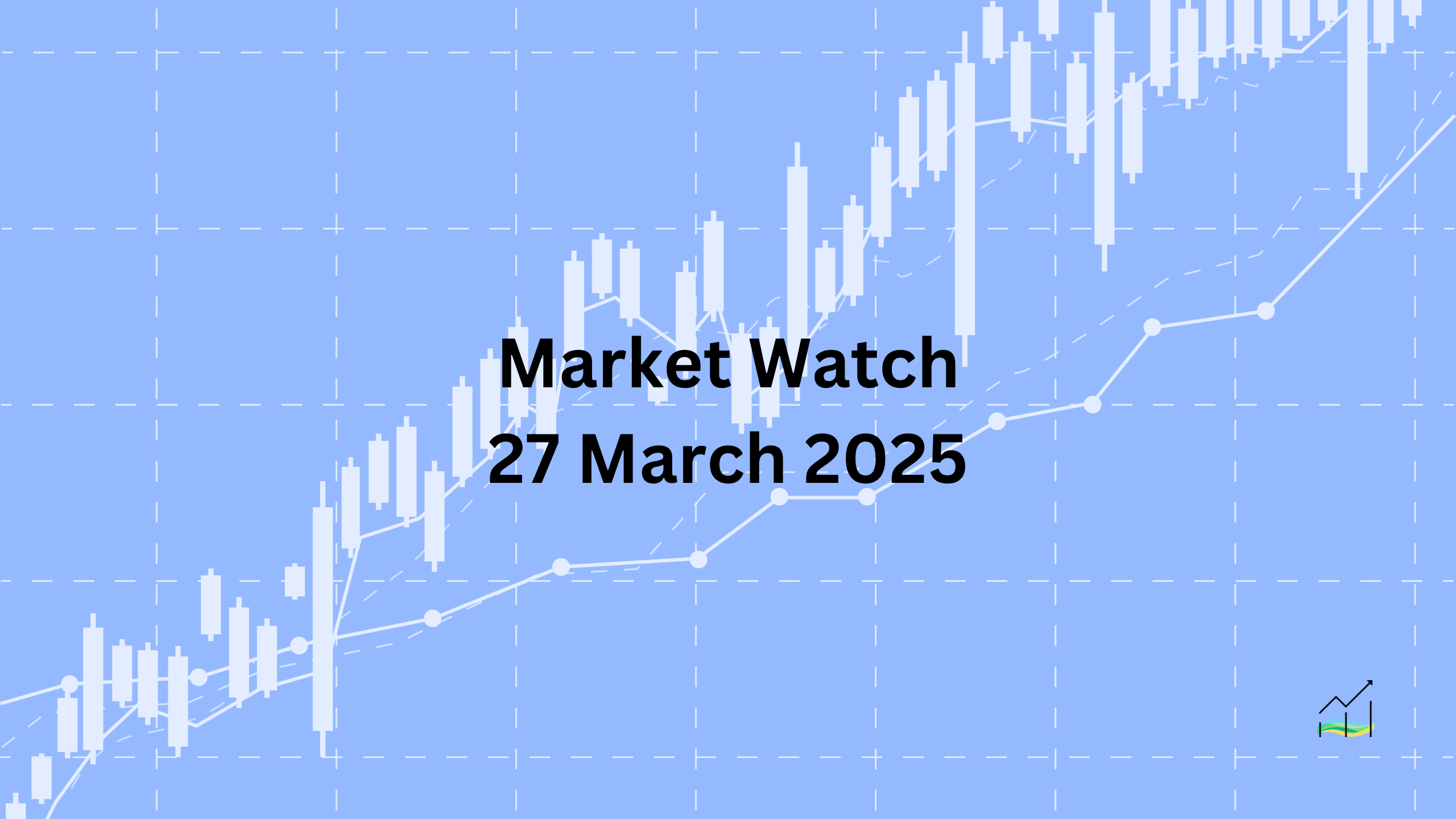27/03/2025 Market Watch

U.S. Auto Tariffs Spark Global Tensions
The United States has imposed a 25% tariff on imported vehicles, escalating trade tensions and drawing global attention. This move, along with hints of further actions next week, reflects a more aggressive protectionist stance. Despite the potential economic impact, financial markets have responded with relative calm, with attention now turning to how US investors will react.
The new tariff, effective April 3, will initially apply to fully assembled vehicles. By May 3, it will extend to key components such as engines, transmissions, powertrains, and electrical systems. Tariffs on vehicles from Mexico and Canada will vary based on domestic content levels. While a White House official claimed the measure could generate up to $100 billion annually, economists widely question the accuracy of that projection.
The administration’s tone is combative, warning of further tariffs if Europe and Canada take coordinated steps perceived as economically harmful to the US. An unusual addition to the rhetoric was a renewed call for US ownership of Greenland, with the President stating the desires of Greenlanders are secondary to US strategic interests—without clarifying the approach to achieving this.
Market reactions remain muted overall. The US dollar is stable within yesterday’s ranges, and gold has risen to its highest level of the week, above $3035. Equities are mixed—Taiwanese markets saw a drop of over 1%, while Europe’s Stoxx 600 slipped modestly, and US futures remain narrowly mixed. In the bond market, yields climbed in Asia but softened slightly in Europe. Notably, the UK’s 10-year Gilt yield jumped 5–6 basis points. The US 10-year Treasury yield also increased, nearing 4.39%, its highest since late February. Oil prices remain steady, with May WTI trading just below the $70 mark after briefly breaking above it yesterday.
United States of America
Overview
The US Dollar Index is holding firm after reaching its highest level since early March, supported by constructive momentum and technical signals. As Q1 draws to a close, attention shifts to updated economic data, including GDP estimates, trade balances, and labor indicators. While Q4 GDP is due today, markets are more focused on early signs of Q1 performance and the impact of trade dynamics. Meanwhile, signs of inventory accumulation and softening housing data add complexity to the economic picture.
Economic Drivers
The underlying fundamentals driving the dollar and broader market expectations include weak Q1 GDP projections, large trade deficits, and signs of softer labor and housing conditions. Despite the Atlanta Fed’s forecast of a 1.8% economic contraction, economists remain skeptical, expecting a less severe slowdown.
- Q1 2025 GDP expectations remain weak, but not as negative as some early models suggest.
- January saw a record goods trade deficit as firms rushed to beat incoming tariffs.
- A 25% surge in gold inventories may signal a further rise in February imports.
- Wholesale inventories are expected to continue climbing, reflecting restocking activity.
- Housing market shows signs of stabilizing after earlier sharp declines.
- Labor market is softening, with slower job growth and a potential uptick in unemployment.
Data and Events
Several key data releases are set to shape short-term expectations and market positioning, particularly around trade and labor.
- Final Q4 2024 GDP reading – due today, but with limited impact as focus shifts to Q1.
- Weekly jobless claims – potential headline risk ahead of next week’s employment report.
- February goods trade balance – expected to remain elevated around $138 billion.
- Wholesale inventory data – forecasted to rise by 0.7% after January's 0.8% gain.
- Pending home sales – expected to have stabilized after nearly 9% decline in Dec-Jan.
Price Action
The Dollar Index is consolidating just below resistance near 104.90–105.00, following a push to 104.70—its highest level since March 5. Support lies between 104.00–104.20. Technical momentum is building, with the five-day moving average on track to cross above the 20-day for the first time in two months, suggesting potential continuation of strength if key resistance breaks.
Key Points:
- Dollar Index hit 104.70, highest since March 5, and remains supported by strong momentum.
- Q1 GDP expectations are weak, but not as negative as early projections suggest.
- February trade deficit remains wide, with upside risk tied to gold imports.
- Wholesale inventories continue to rise after H2 2024 liquidation.
- Labor and housing indicators show early signs of softening.
- Upcoming data on GDP, trade, inventories, and jobless claims will shape near-term sentiment.
Australia
Overview
The Australian dollar has weakened after briefly touching a four-day high, reversing lower amid a risk-off mood in North American markets. Despite fiscal support announced ahead of the upcoming Australian election, external pressures and yield differentials continue to influence the currency’s performance. Current price action remains within the previous day’s range, as traders assess broader macro factors and technical levels.
Economic Drivers
The Australian dollar’s movements are being shaped by both domestic policy developments and shifts in relative interest rates. Although recent fiscal stimulus was introduced, the narrowing of the yield discount with the US earlier in the month supported a recovery in the currency—until widening spreads returned to apply pressure.
- Australian government introduced tax cuts and fiscal measures ahead of May’s election.
- AUD/USD previously rebounded from February lows as the yield gap with the US narrowed.
- The two-year yield spread shrank from over 50 basis points to just 8 bps earlier this month.
- The spread has since widened again to over 30 bps but currently sits around 25 bps.
- Broader risk-off sentiment continues to weigh on the Australian dollar.
Data and Events
While no high-impact economic data was released with direct influence on the latest price action, broader election-related fiscal policy and interest rate differentials remain relevant.
- Pre-election fiscal stimulus from the Australian government, including tax cuts.
- Ongoing market focus on yield spreads between Australian and US two-year bonds.
- Political and fiscal developments leading into May's national election.
Price Action
The Australian dollar reached a high near $0.6330 before reversing sharply lower and breaching Tuesday’s low by a fraction. It slipped through $0.6280 and remains within yesterday’s range. Last week’s low was just under $0.6230. If bearish momentum continues, key support near $0.6230 could be retested. Volatility is increasing around key levels amid risk-off flows and technical positioning.
Key Points:
- AUD/USD reversed from a four-day high near $0.6330, slipping below $0.6280.
- Price action remains inside yesterday’s range, with key support near $0.6230.
- Australian government announced tax cuts and fiscal measures ahead of May’s election.
- The AUD’s earlier recovery was driven by a narrowing US-AU two-year yield spread.
- That spread has widened again to around 25 bps, pressuring the currency.
- Global risk-off sentiment contributed to the recent weakness in the Australian dollar.
Canada
Overview
The Canadian dollar weakened after briefly touching a new monthly high, as rising global risk aversion and renewed US tariff threats triggered a broad shift back toward the US dollar. Equity market losses and geopolitical uncertainty contributed to the reversal, while narrowing US-Canada yield spreads provided some cushion to the loonie. Political developments in Canada, with elections just a month away, also factor into sentiment.
Economic Drivers
The exchange rate has been influenced by both global risk sentiment and relative bond yields. Despite election promises of fiscal support in Canada, the narrowing yield discount to the US has played a key role in cushioning the Canadian dollar's downside.
- Both major Canadian political parties are pledging fiscal support ahead of the election.
- Canada's 10-year bond yield discount to the US narrowed from ~150 bps in early February to ~120 bps.
- The 2-year yield spread has also narrowed by around 20 bps from its peak near 164 bps.
- Broader risk-off sentiment is favoring the US dollar as a safe-haven currency.
Data and Events
Although there were no major economic data releases directly moving the CAD, upcoming events and political factors remain relevant to market positioning.
- Canadian federal election is one month away, with campaign activity intensifying.
- Fiscal proposals from leading candidates are being closely watched for their potential economic impact.
- Market focus remains on potential US auto tariffs, which could affect trade and sentiment.
Price Action
The US dollar briefly fell to a new monthly low against the Canadian dollar near CAD1.4235 but reversed sharply amid broader market risk aversion. It climbed back toward CAD1.4300 by the end of the day and extended gains to nearly CAD1.4320 today. The sharp recovery highlights the loonie’s vulnerability to external shocks, particularly when risk appetite fades.
Key Points:
- USD/CAD dropped to a new monthly low near 1.4235 before rebounding strongly.
- The rebound was driven by US tariff threats and sharp equity market losses.
- The Canadian 10-year and 2-year yield spreads vs. the US have both narrowed.
- Canadian election campaigns are underway, with fiscal policy promises in focus.
- Risk-off flows continue to support the US dollar as safe-haven demand increases.
China
Overview
The offshore yuan has weakened against the US dollar for seven straight sessions, marking its longest losing streak since October 2022. This sustained slide comes amid a lack of intervention from Chinese authorities, suggesting tolerance for further depreciation. The dollar is holding near recent highs, and attention is turning to key technical chart levels as policy signals remain mixed.
Economic Drivers
The yuan's decline is being shaped by broader dollar strength, China's policy posture, and market expectations surrounding the PBOC’s currency management. The absence of resistance from Beijing reinforces speculation that the authorities may be comfortable with a weaker yuan to support growth.
- The offshore yuan has declined for seven consecutive sessions, the longest streak since Oct 2022.
- No signs of active intervention or resistance from Chinese officials.
- Persistent US dollar strength continues to apply downward pressure on the yuan.
- A weaker yuan could align with Beijing’s broader pro-growth policy stance.
Data and Events
The People's Bank of China has sent mixed signals through daily reference rate settings, alternating between support and easing over the past week.
- The US dollar reached CNH7.2825 yesterday, the highest since March 4.
- The PBOC cut the reference rate yesterday after four straight increases, but raised it again today (CNY7.1763 vs. CNY7.1754).
Price Action
The dollar-yuan pair has pushed toward CNH7.2825, holding just below that level today. The next technical area of interest lies near CNH7.2945, which marks the midpoint of the dollar's decline from its Q1 peak. The chart signals remain constructive for further dollar gains if the yuan continues to weaken without policy intervention.
Key Points:
- Offshore yuan has declined for seven straight sessions, the longest drop since Oct 2022.
- No resistance from Beijing suggests tolerance for currency weakness.
- US dollar is near recent highs, with next resistance around CNH7.2945.
- PBOC adjusted its reference rate upward today after a brief dip yesterday.
- Policy cues remain mixed, but dollar momentum and technical setup favor further upside.
Europe
Overview
The euro briefly dipped below key technical support before recovering, as interest rate differentials and improving eurozone credit growth shape the broader narrative. Despite settling below its 20-day moving average for the first time this month, buyers stepped in near the $1.0725–$1.0730 zone, pushing the currency higher in today’s session. Meanwhile, eurozone credit data supports early signs of recovery, although market sensitivity to monetary aggregates has diminished over time.
Economic Drivers
The euro’s recent movements are underpinned by widening yield spreads and subtle improvements in eurozone credit conditions. The US-German two-year yield spread remains a significant factor in the euro’s trajectory.
- US two-year yield premium over Germany is near 188 basis points.
- The spread is over 20 basis points above the five-month low seen on March 10.
- Eurozone credit growth is improving, signaling potential recovery in the region.
- Broader market reactions to money supply data have softened compared to prior years.
Data and Events
Economic data from the eurozone highlighted a continued rise in broad money supply, with additional evidence of improved lending activity.
- Eurozone M3 money supply rose 4% YoY in February, up from 3.8% in January.
- Ongoing improvements in credit growth align with early recovery signs in the region.
Price Action
The euro settled below its 20-day moving average (~$1.0770) for the first time this month and fell through yesterday’s low near $1.0745. Buyers emerged just above key support at $1.0725–$1.0730, and the currency has since rebounded toward $1.0790. This bounce suggests short-term demand remains intact, though resistance at the 20-day moving average may pose a technical hurdle.
Key Points:
- Euro dipped below the 20-day MA but found support near $1.0725–$1.0730.
- Recovered to approach $1.0790 in today's session.
- US-German two-year yield spread widened to ~188 bps, limiting euro gains.
- Eurozone M3 rose 4% YoY; credit growth continues to improve.
- Market response to money supply figures remains muted, unlike in past cycles.
Japan
Overview
The US dollar continues to recover from its March 11 low against the Japanese yen, maintaining upward momentum supported by firm US yields and positive technical signals. The dollar has been consolidating just below key resistance levels, with investor flows showing shifting preferences between Japanese and foreign assets. Despite modest foreign bond buying by Japanese investors, foreign interest in Japanese bonds has surged, while Japanese equities face heavy selling pressure from abroad.
Economic Drivers
The yen’s weakness is being driven by yield differentials, investor portfolio flows, and improving dollar momentum. Japanese investors appear more cautious in foreign bond markets this year but are increasingly active in foreign equities, while foreign investors are showing growing demand for Japanese bonds but are pulling back from Japanese stocks.
- US 10-year yield remains at the high end of its March range, supporting the dollar.
- Japanese investors have slowed weekly foreign bond purchases (~JPY222 bln vs. ~JPY478 bln last year).
- They are increasing foreign equity purchases (~JPY181 bln vs. ~JPY15.1 bln last year).
- Foreign investors are ramping up Japanese bond buying (~JPY457 bln vs. ~JPY60 bln last year).
- However, foreign investors are selling Japanese equities heavily (~–JPY430 bln net/week).
Data and Events
Recent weekly reports from Japan’s Ministry of Finance reveal clear trends in cross-border investment flows, shaping expectations around capital movement and currency direction.
- Weekly MOF portfolio data for 2025 highlights changes in Japanese and foreign investment behavior.
- Decline in Japanese investor demand for foreign bonds compared to early 2024.
- Strong pickup in foreign investor appetite for Japanese bonds.
- Persistent foreign net selling in Japanese equities.
Price Action
The dollar's recovery from JPY146.55 on March 11 remains intact. It reached JPY150.95 earlier this week and continues to trade within yesterday's range, holding above JPY150.00. Resistance is seen near the monthly high at JPY151.30, with a more significant barrier in the JPY151.65–JPY151.70 zone. Momentum indicators are pointing higher, and the five-day moving average crossed above the 20-day on March 20—the first bullish crossover since mid-January.
Key Points:
- USD/JPY recovery remains firm, with current support at JPY150.00.
- Resistance levels to watch: JPY151.30 (monthly high) and JPY151.65–151.70.
- US yields remain elevated, supporting the dollar’s uptrend.
- Japanese investors are reducing foreign bond buying but increasing foreign equity exposure.
- Foreign investors are buying Japanese bonds but exiting Japanese equities.
- Momentum and technical signals continue to favor a stronger dollar.
United Kingdom
Overview
The British pound weakened following softer-than-expected inflation data and a budget announcement that failed to inspire confidence. Selling pressure pushed sterling below its 20-day moving average for the first time in over a month, before it staged a modest intraday rebound. With technical indicators turning lower, the short-term outlook appears fragile unless strong support levels hold.
Economic Drivers
Sterling’s decline was driven primarily by a dip in February’s inflation reading and market disappointment following the Chancellor’s latest budget statement. Both developments reduced expectations for near-term policy tightening and undermined sentiment.
- February CPI came in lower than expected, weakening inflation pressures.
- The UK budget announcement failed to generate optimism or market support.
- Market pricing now reflects reduced urgency for additional monetary tightening.
- Slowing inflation raises questions about the Bank of England’s next policy steps.
Data and Events
The currency’s move was largely triggered by two key developments in the UK’s macro calendar.
- February CPI data signaled a downtick in inflation.
- Chancellor Reeve's budget statement contributed to market selling.
Price Action
Sterling dropped below its 20-day moving average (~$1.2885) for the first time since mid-February and hit a new low near $1.2870. It then rebounded toward $1.2930 intraday. Initial support is now seen around $1.2840–$1.2860, with deeper support between $1.2785–$1.2800. Momentum indicators are declining, and the five-day moving average is close to crossing below the 20-day average—a bearish signal not seen in two months.
Key Points:
- Sterling fell after weaker February CPI and an underwhelming budget statement.
- The drop pushed GBP/USD below its 20-day moving average for the first time since mid-Feb.
- It hit a low near $1.2870 before recovering to almost $1.2930.
- Support levels lie at $1.2840–$1.2860 and deeper at $1.2785–$1.2800.
- Momentum indicators are falling; a bearish moving average crossover is likely.
© 2025 SKONE Enterprise (003319453-V). All rights reserved.
The content on this site is for informational purposes only and does not constitute financial advice.


